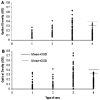Autoantibodies to tumor-associated antigens combined with abnormal alpha-fetoprotein enhance immunodiagnosis of hepatocellular carcinoma
- PMID: 19683863
- PMCID: PMC2823929
- DOI: 10.1016/j.canlet.2009.07.016
Autoantibodies to tumor-associated antigens combined with abnormal alpha-fetoprotein enhance immunodiagnosis of hepatocellular carcinoma
Abstract
The identification and characterization of tumor-associated antigens (TAAs) and their use in antigen mini-arrays for cancer immunodiagnosis has been of interest recently as an approach to cancer detection. In this study, autoantibodies in sera from a patient with HCC were used as probes to immunoscreen a HepG2 cDNA expression library for the identification of TAAs involved in malignant liver transformation. Recombinant proteins from two genes identified in this manner, Sui1 and RalA were expressed, purified and used as antigens in immunoassays to detect the presence of antibodies in sera from 77 patients with HCC, 30 with chronic hepatitis (CH), 30 with liver cirrhosis (LC) and 82 normal human sera (NHS). The prevalence of antibody to Sui1 and RalA in HCC were 11.7% (9/77) and 19.5% (15/77), respectively, which were significantly higher than prevalence in liver cirrhosis (3.3% and 3.3%), chronic hepatitis (0% and 0%) and normal human sera (0% and 0%). When Sui1 and RalA were added to a panel of eight other TAAs used in a previous study, the final cumulative prevalence of anti-TAA antibodies in HCC to the 10 TAA array was raised to 66.2% (51/77). The specificity for HCC compared with LC, CH and NHS, was 66.7%, 80.0%, and 87.8%, respectively. When anti-TAA was added to abnormal serum AFP as combined diagnostic markers, it raised the diagnostic sensitivity from 66.2% to 88.7%. AFP and anti-TAA were independent markers and the simultaneous use of these two markers significantly resulted in the increased sensitivity of HCC detection.
Copyright 2009 Elsevier Ireland Ltd. All rights reserved.
Conflict of interest statement
Figures


Similar articles
-
Autoantibody response to Sui1 and its tissue-specific expression in hepatocellular carcinoma.Tumour Biol. 2016 Feb;37(2):2547-53. doi: 10.1007/s13277-015-4074-y. Epub 2015 Sep 19. Tumour Biol. 2016. PMID: 26386724
-
Using immunomic approach to enhance tumor-associated autoantibody detection in diagnosis of hepatocellular carcinoma.Clin Immunol. 2014 May-Jun;152(1-2):127-39. doi: 10.1016/j.clim.2014.03.007. Epub 2014 Mar 22. Clin Immunol. 2014. PMID: 24667685 Free PMC article.
-
Antibody detection using tumor-associated antigen mini-array in immunodiagnosing human hepatocellular carcinoma.J Hepatol. 2007 Jan;46(1):107-14. doi: 10.1016/j.jhep.2006.08.010. Epub 2006 Sep 25. J Hepatol. 2007. PMID: 17067715 Free PMC article.
-
Mini-array of multiple tumor-associated antigens to enhance autoantibody detection for immunodiagnosis of hepatocellular carcinoma.Autoimmun Rev. 2007 Jan;6(3):143-8. doi: 10.1016/j.autrev.2006.09.009. Epub 2006 Oct 10. Autoimmun Rev. 2007. PMID: 17289549 Free PMC article. Review.
-
Autoantibodies to tumor-associated antigens as diagnostic biomarkers in hepatocellular carcinoma and other solid tumors.Expert Rev Mol Diagn. 2010 Apr;10(3):321-8. doi: 10.1586/erm.10.12. Expert Rev Mol Diagn. 2010. PMID: 20370589 Free PMC article. Review.
Cited by
-
Mini-array of multiple tumor-associated antigens (TAAs) in the immunodiagnosis of breast cancer.Oncol Lett. 2013 Feb;5(2):663-668. doi: 10.3892/ol.2012.1062. Epub 2012 Dec 5. Oncol Lett. 2013. PMID: 23420714 Free PMC article.
-
A novel immunodiagnosis panel for hepatocellular carcinoma based on bioinformatics and the autoantibody-antigen system.Cancer Sci. 2022 Feb;113(2):411-422. doi: 10.1111/cas.15217. Epub 2021 Dec 14. Cancer Sci. 2022. PMID: 34821436 Free PMC article.
-
Preferential autoimmune response in prostate cancer to cyclin B1 in a panel of tumor-associated antigens.J Immunol Res. 2014;2014:827827. doi: 10.1155/2014/827827. Epub 2014 Apr 17. J Immunol Res. 2014. PMID: 24860838 Free PMC article.
-
A cancer-related protein 14-3-3ζ is a potential tumor-associated antigen in immunodiagnosis of hepatocellular carcinoma.Tumour Biol. 2014 May;35(5):4247-56. doi: 10.1007/s13277-013-1555-8. Epub 2014 Jan 4. Tumour Biol. 2014. PMID: 24390614 Free PMC article.
-
Efficacy of early treatment on 52 patients with preneoplastic hepatitis B virus-associated hepatocellular carcinoma by compound Phyllanthus Urinaria L.Chin J Integr Med. 2014 Apr;20(4):263-71. doi: 10.1007/s11655-013-1320-7. Epub 2013 Mar 25. Chin J Integr Med. 2014. PMID: 23529834 Clinical Trial.
References
-
- Imai H, Nakano Y, Kiyosawa K, Tan EM. Increasing titers and changing specificities of antinuclear antibodies in patients with chronic liver disease who develop hepatocellular carcinoma. Cancer. 1993;71:26–35. - PubMed
-
- Covini G, Muhlen CAV, Pacchetti S, Colombo M, Chan EKL, Tan EM. Diversity of antinuclear antibody responses in hepatocellular carcinoma. J Hepatol. 1997;26:1255–1265. - PubMed
Publication types
MeSH terms
Substances
Grants and funding
LinkOut - more resources
Full Text Sources
Other Literature Sources

